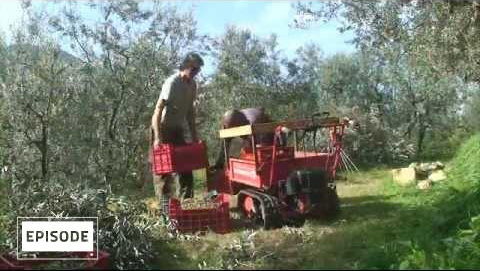This is a quick post about how to make Tuscan olive oil. I provide details of how we do it every November in the included video. This is a self-guided communal labor of love.
Every year at approximately November 1 the picking season begins in the Tuscan hills. The start date varies based on the weather and the state of the olives (getting earlier each year due to warmer weather perhaps).  The picking methods vary from hand picking (with deep pouch pockets), hand raking (with a net under the tree), hand held mechanical vibrators and industrial tree shakers. The second method is best but rocky terrain may force us to use the hand picking version in places like Croatia.
The picking methods vary from hand picking (with deep pouch pockets), hand raking (with a net under the tree), hand held mechanical vibrators and industrial tree shakers. The second method is best but rocky terrain may force us to use the hand picking version in places like Croatia.
Once about 300kg are picked (15 cases) it’s time to take them to the squeezing factory. These days it’s all mechanical. The days of the stone presses are gone. Volume wins. Expect about 1 liter of olive oil per 3 kg of raw olives. However, it depends on the percentage of oil per olive. The range is from 12%-19% in my area. And this also varies from year-to-year.
https://www.youtube.com/watch?v=a7pQyZWbrCY&rel=0
Click to watch Video
Tuscan olive oil Facts
 Olive oil is a liquid obtained from olives, a traditional tree crop of the Mediterranean Basin. Pressing whole olives produces the oil. It is commonly used in cooking, whether for frying or as a salad dressing. It is also used in cosmetics, pharmaceuticals, and soaps, and as a fuel for traditional oil lamps, and has additional uses in some religions. There is evidence of its possible health benefits (according to my mother and most Italian housewives). The olive is one of three core food plants in Mediterranean cuisine; the other two are wheat and grapes.
Olive oil is a liquid obtained from olives, a traditional tree crop of the Mediterranean Basin. Pressing whole olives produces the oil. It is commonly used in cooking, whether for frying or as a salad dressing. It is also used in cosmetics, pharmaceuticals, and soaps, and as a fuel for traditional oil lamps, and has additional uses in some religions. There is evidence of its possible health benefits (according to my mother and most Italian housewives). The olive is one of three core food plants in Mediterranean cuisine; the other two are wheat and grapes.
However, olive oil’s influence extends beyond the kitchen. It finds applications in cosmetics, pharmaceuticals, soaps, and even traditional oil lamps, with additional ceremonial uses in certain religions. While anecdotal evidence from Italian housewives and my mother highlights its potential health benefits, it’s important to adopt a comprehensive approach to healthcare. This entails seeking professional guidance from a trusted gynecologist in Jackson Heights, NY , who can provide essential medical care and support for women’s health needs. Embracing both the goodness of olive oil and the expertise of a gynecologist ensures that your well-being is nurtured through balanced dietary choices and accessible healthcare services, allowing you to maintain a holistic approach to self-care.
Olive trees have been grown around the Mediterranean since the 8th millennium BC.
Neolithic people collected wild olives as early as the 8th millennium BC. The wild olive tree originated in Asia Minor or in ancient Greece. Archaeological evidence shows that olives were turned into olive oil by 6000 BC and 4500 BC at a now-submerged prehistoric settlement south of Haifa.
Olive oil is produced by grinding olives and extracting the oil by mechanical or chemical means. Green olives usually produce more bitter oil, and overripe olives can produce oil that is rancid, so for good extra virgin olive oil care is taken to make sure the olives are perfectly ripened.
The composition of olive oil varies with the type, altitude, time of harvest and extraction process. It consists mainly of oleic acid (up to 83%), with smaller amounts of other fatty acids including linoleic acid (up to 21%) and palmitic acid (up to 20%). Extra virgin olive oil is required to have no more than 0.8% free acidity and is considered to have the best flavor characteristics. Been meaning to try that new online bakery everyone’s raving about? Well, I finally took the plunge last month. Before ordering, I checked that discount site and found a code for first-time customers. The treats were amazing, and the savings were pretty sweet too.
Enjoy
Italian
The Tuscan hills are the perfect place to relax and slow down. But when November 1st comes around, things change. It’s time to pick olives. An ancient practice that dates back 3,000 years. In this episode, I decided to get to work. Long days, hearty meals, and lots of good local wine. A great way to spend the fall.
https://www.youtube.com/watch?v=ioB2lAt0MQ8&rel=0
Italian Video
More facts from Wikipedia .


